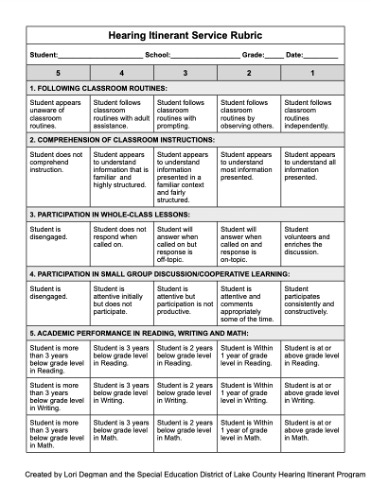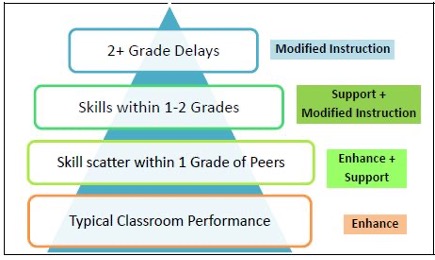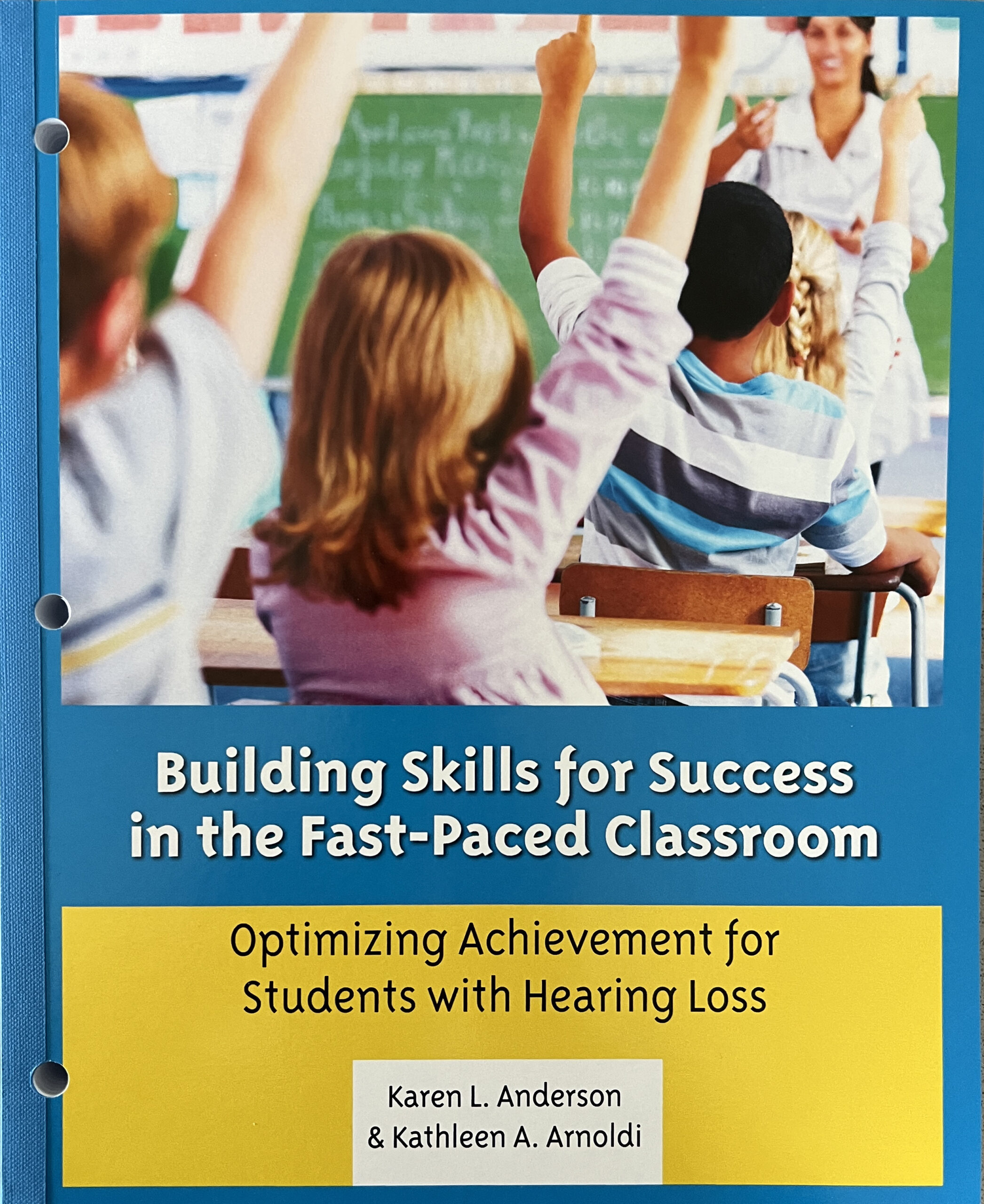Related Products
For Professionals
- Amplification
- Assessment of Student Skills, Challenges, Needs
- Early Childhood: Infants, Toddlers, Preschool
- Hearing Loss – Identification, Impact and Next Steps
- IDEA Law Summary Information
- Language and Speech Development Issues
- Legal Issues in Serving Children with Hearing Loss
- Listening (Auditory Skills) Development
- Planning to Meet Student Needs
- Self-Advocacy Skills for Students with Hearing Loss
- Self-Concept: How the Child with Hearing Loss Sees Himself
- Social Skills
- Speech Perception & Learning
Related Teacher Tools Takeout Items
Student Services: One Size Doesn’t Fit All
Determining Service Delivery for Students with Hearing Loss can be Tricky
 It would be a lot easier if we had one-size-fits-all services for our students with hearing loss, but the law requires we tailor service delivery to every student’s individual needs. Student needs cannot be appropriately dictated by degree of hearing loss, hearing technology, their age or any other factor. Only with data can we develop appropriate education plans. This article will review this tailoring process and variables that must be considered.
It would be a lot easier if we had one-size-fits-all services for our students with hearing loss, but the law requires we tailor service delivery to every student’s individual needs. Student needs cannot be appropriately dictated by degree of hearing loss, hearing technology, their age or any other factor. Only with data can we develop appropriate education plans. This article will review this tailoring process and variables that must be considered.
Since students present with varying degrees and types of hearing loss, a full evaluation of the student’s strengths and weakness should be completed by a multidisciplinary team that includes the Teacher of the Deaf/Hard of Hearing (TODHH). For an example of checklists specific to different team members, look at the Access to Curriculum Inventory.
| As part of the functional performance testing, the TODHH will do a classroom observation as well as ask the general education teachers, specific questions about the student’s ability to access classroom information in a variety of settings. This information will impact the decision for service delivery. |
It’s critical to know if the student is accessing auditory information in small and large groups, in noise and in quiet, in ideal acoustical settings and those with the least ideal acoustics (i.e., the gym or cafeteria). Knowing how well the student follows classroom routines, comprehends auditory directions, and their level of class participation, will help the team determine the time and delivery method for hearing support services. The student’s age of identification can help gauge the amount of language they may have been exposed to in a natural setting as well as auditory skill development and self-advocacy skill development.
Considerations:
| 1. | Student’s needs: academics AND functional performance. It is NOT necessary for a student to have an achievement gap as a sole criterion for adverse educational effect. |
| 2. | Special considerations: requires the team to look at how and how well a student can communicate with others in the classroom setting, including the impact of the hearing loss on perception of classroom communication at a distance and in background noise. |
| 3. | Does the hearing loss cause an adverse effect to education (performance in the classroom; achievement)? |
| 4. | Does he/she have the listening, communication repair, self-advocacy skills and self-concept needed to be able to compensate for the access issues caused by the hearing loss and fully participate in the classroom? If the student’s access issues are a barrier to full participation, then challenges to functional performance in the classroom is likely. Hearing loss results in reduced incidental language learning often resulting in language gaps, including pragmatic language and social interaction issues. |
| 5. | What services (teaching skills) and supports (ensuring access) are needed for the student to receive equal benefit of education in the general education setting? |
|
Sometimes administrators or classroom teachers ask:
According to the Individuals with Disability Education Act, IDEA Section 300.115 (a) Each public agency must ensure that a continuum of alternative placements is available to meet the needs of children with disabilities for special education and related services. (b) The continuum required in paragraph (a) of this section must– (1) Include the alternative placements listed in the definition of special education under Sec. 300.38 (instruction in regular classes, special classes, special schools, home instruction, and instruction in hospitals and institutions); and (2) Make provision for supplementary services (such as resource room or itinerant instruction) to be provided in conjunction with regular class placement. (Authority: 20 U.S.C. 1412(a)(5) )
Only a Teacher of the Deaf and Hard of Hearing is qualified to interpret the results to the portions of functional hearing assessments that were part of the original evaluation. Only a TODHH can make recommendations for students with hearing loss regarding appropriate service delivery to meet the students’ unique needs related to the impact of hearing loss on access to information. Only a TODHH can ensure that alternative placements in special education are or are not appropriate given the students hearing needs. Therefore, there must be a TODHH on the IEP team making the recommendations for service delivery in a student’s IEP. |
Once the team determines the amount of service provision, then the team must determine the appropriate model for service delivery or type of service. Some students do better in settings that they are pulled from the general education setting and receive instruction in a 1:1 setting for hearing support. Other students do better in the general education setting with the hearing support teacher co-teaching in an inclusion model. This is all determined by the IEP team once all evaluation information, including the impact of communication barriers, has been reviewed and considered.
The team will make a recommendation for amount of services, both direct (face time directly with the student) and indirect service time that includes monitoring and consultation for the student. TODHH often collaborate with the general education teachers, Speech-Language Pathologists, Educational Audiologists, parents and other staff members as part of their consultation time. When documenting this in the IEP the team must remember to address service time as in how often, for how long and how the students will be delivered services and location of service.
Once the team makes a decision on service delivery, amount of time per school year, frequency, duration, location and model of services, the team can add that information to the IEP and, if necessary, reconvene to adjust as appropriate.
Take caution that you allow enough time to appropriately delivery instruction in the area of need, allow enough time for practicing skills and progress monitoring skills. If the student has a secondary transition plan, be sure to allot time for adequately addressing activities and instruction in secondary transition.
Consultation and monitoring takes time so be sure to allocate time to email teachers, consult with other professionals, contact the parents and gather data for progress monitoring.
Resources:
 Hearing Itinerant Service Rubric from District of Lake County Hearing Itinerant Program provides a matrix to assist teams in ensuring students have an adequate amount of time and that the service delivery models are appropriate to meet the students needs. See PDF here.
Hearing Itinerant Service Rubric from District of Lake County Hearing Itinerant Program provides a matrix to assist teams in ensuring students have an adequate amount of time and that the service delivery models are appropriate to meet the students needs. See PDF here.
The Region 4 Deaf or Hard of Hearing (DHH) Itinerant Teacher Professional Learning Community (PLC) in Houston, Texas created a rubric to help teachers gauge service delivery.
Charts: Model of Service Delivery + Response to Intervention Supports for Children with Hearing Loss
Models of Support Services (availability of services from an itinerant teacher of the deaf/hard of hearing)

For more information on
- the Inclusion Model please see the article, Is the Inclusion Model Good for Students with Hearing Loss? Supporting Success Bimonthly Update article, Early October 2017.
- the Adverse Educational Affect please see the article Support for Showing Adverse Educational Affect Due to Hearing Loss
- involving the TODHH on a Multidisciplinary Team please refer to the article Why Involve the Teacher of the Deaf/Hard of Hearing on the Assessment Team and the IEP?
The information within this article has been derived from sections of the law, Office of Special Education Program comments and discussion provided at the U.S. Department of Education’s Individuals with Disabilities Education Act (IDEA). The guidance provided in this website helps clarify the intent of IDEA and may be useful to professionals and parents alike who are trying to advocate appropriate services and supports for children with hearing loss. This article is not legal advice.
Author: Michelle Andros, MSEd.


